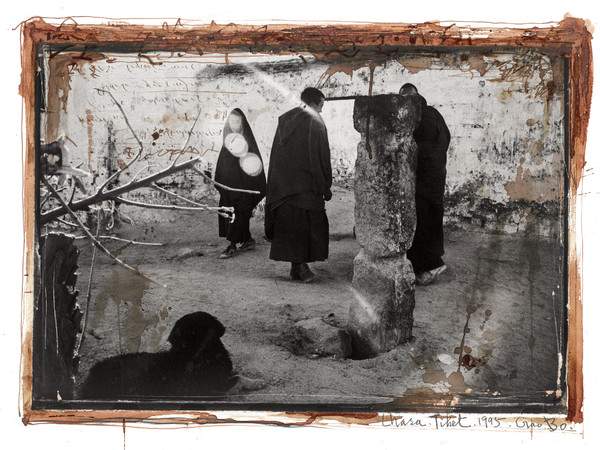WITH GAO BO高波 OFFER Venice-Himalaya, the first solo exhibition in Italy by artist, photographer and performer Gao Bo (Deyang City-Sichuan, 1964), opens in Venice the new IN’EI gallery, a space that aims to promote artists and works from China, Japan and Korea and create an open dialogue between these countries andEurope. Running from March 12 to April 24, 2023, the exhibition, curated by Pietro Gaglianò, presents a series of works, including a site-specific environmental installation, that reveal the vision of the artist, who was born in China and has lived in Paris for many years, as a child of the experiences and traditions of these cultural and geographic areas, which is perfectly in line with the gallery’s goals.
“The intention is to work with a few selected names that we have decided to invest in, triggering long-term paths with established and emerging artists, enhancing the authors and producing ad hoc works specifically conceived for us,” explains Hélène Dubois, founder of the space together with Patrice Dumand. “Our goal is a proposal that includes and brings together art and design. With this first exhibition, we want to welcome an audience of enthusiasts and present works and thoughts deeply rooted in Asian culture, but also reveal a specific sensibility and propose an interpretation of the relationships between different cultural basins.” GAO BO高波 OFFER Venice-Himalaya marks the artist’s return to the international art scene after a long hiatus, almost like a rebirth.
The main work in the exhibition, which gave birth to the project, is Mandala offering, Tibet, an environmental photographic installation composed of a thousand stones-a number that in Tibetan culture definesInfinity-directly inspired by marniy stones, a devotional element of Tibetan Buddhist spirituality. On each stone, Gao Bo has imprinted photographic portraits of women and men, young and old, and a series of numbers that refer to the inhumane practice of numbering prisoners, an act of depersonalization practiced by all regimes.
This work, made in 2012 and now reinterpreted, stems from the artist’s strong connection to Tibetan culture and is not only an offering to the people depicted, and to all their people, but also a reflection on life, death, memory, and the relativity of time.
Neon underscores the nonverbal writing created by Gao Bo who chooses to use a language that had not been used for violence, for abuse, for oppression. “Il n’y pas de langue qui ne soit pas dangereuse” (There is no language that is not dangerous) is the phrase in the installation that highlights the artist’s vision.
Like an offering, in the artist’s intentions the work will only complete its journey when it is purchased by someone who will bring it back to Tibet. A back home that will be documented in a documentary filmed by the artist together with the collector, which will close a cycle and, as a kind of “liberation,” open a new phase for Gao Bo. Alongside the installation, the exhibition also includes A Thousand Silent Prayers, an unpublished work, a portfolio in a special limited edition box set (25 copies) signed by the artist, with ten engravings made from Mandala offering photographs. Like a wordless list, the faces portrayed continue to question the viewer even from this new composition.
The tour is then completed with the artist’s book TIBET 1985-1995. Photographs par Gao Bo (pictured), co-published by the MEP European Museum of Photography in Paris and Artron, China’s leading fine arts book printer and publisher. A publication that offers privileged access to the artist’s work and his relationship with Himalayan culture through images chosen from among several thousand taken by the artist in 35mm black-and-white between 1985 and 1995 during several trips to Tibet.
Consisting of two limited and numbered edition notebooks (1 to 50), the book-event brings together 146 prints already in the collections of prestigious museums and institutions around the world.
“The sensitivity to the subject matter, the subject matter of many of the works and a special feeling for time belong to the Asian side of Gao Bo’s cultural upbringing,” points out Pietro Gaglianò, curator of the exhibition , “The lexicon adopted, the linguistic choices, the inclination for the figure are instead ascribable to the European world. In this way, by experimenting with unprecedented convergences, all of which are profoundly authentic, the observation of his work can provide an answer to an important historical question: the cultural consequences of European colonization are still ongoing, and in the present time it is as important as ever to free artistic expression as much from the neocolonial condemnation of localism, typicality, and folklore as from the trends dictated by market systems.”
Gao Bo’s idea of art-whose research is grounded in both worlds, which she inhabits-completely reflects that with which IN’EI was born and which leads her to create new connections between East Asia and Europe by proposing projects created to enhance works and artists identified through careful field research and in-depth knowledge ofEast Asia by founders Hélène Dubois and Patrice Dumand.
 |
| New IN'EI gallery opens in Venice with the first exhibition in Italy by photographer Gao Bo |
Warning: the translation into English of the original Italian article was created using automatic tools. We undertake to review all articles, but we do not guarantee the total absence of inaccuracies in the translation due to the program. You can find the original by clicking on the ITA button. If you find any mistake,please contact us.